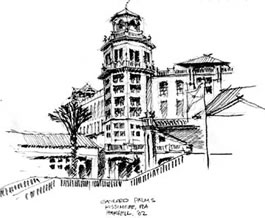
Essential Partners in Patient Care
International conference on health facility planning, design, and construction
From the conference proceedings by John Blignaut, AIA, and Sara Malone
The AIA Academy of Architecture for Health (AAH) gives us a great example of a professional interest area with much to offer its members. The following article appears on the new AAH Web site, which was launched in HTML format on May 17. Also check the Web site for more conference proceedings, details on the upcoming fall conference "Evolving Design of the Emergency Department 2002," research reports, and news from the Academy of Healthcare Architects.
"We need a way to think about the future of health care," said Joe Flower, principal and founder of the Change Project, who served as keynote speaker for the "American Society of Healthcare Engineering Planning and Design Conference 2002: Essential Partners in Patient Care" international conference on health facility planning, design, and construction, March 25–27.
"Many say that it's not working; that we're missing something," Flower explained. "The next 20 years will be a time of amazing change, yet the industry seems stuck right now."
 Game
theory
Game
theory
Flower spoke about how John Nash, about whom the movie "A Beautiful
Mind" was based, changed our long-held theory of games. Before he
altered our perceptions, games were considered finite, competitive, with
clear rules, zero-sum outcomes, and transferable payoffs. Nash asked if
there are ways to make equations describe something larger.
Nash determined that:
• Rules are negotiable
• There can be infinite games (like the stock market)
• There can be cooperative and noncooperative games
• There can be non-zero-sum games
• There can be games with payoffs that are not transferable.
Games have different strategies, resources, and relationships, including relationships of influence. This all stabilizes in a place called "local optima," which means it's the best you can do in a given situation.
Does this work for
health care?
"How do we map this [concept] onto health care?" Flower asked.
If we consider that vendors, builders, and payers all exert various levels
of control and influence, there are many possible stable solutions. Flower
called this the "Nash Equilibrium." Of course, with each factor
in the solution comes a possible source of conflict to disrupt this equilibrium.
Technology will be the major factor that shifts the foundations of health care's equilibrium and allows change, predicted Flower. He explained that biotechnology and clinical and information technologies all are integral to health care and the consideration of what the "local optima" should be. For instance, biotechnology includes genomics, which will allow us to develop customized prescriptions based on genes and will allow lifelong health profiling. According to Flower, some emerging pharmaceuticals will also deeply affect hospitals and their bottom lines. For example, AGI 1067, a drug that protects the arteries after angioplasty, will cost $100 per month, while Gleevac, a cancer-fighting drug, will cost $2,400 per month. There is no established way to pay for this sort of treatment right now, and such life-saving drugs will be out of the reach of most in the U.S. and completely unavailable for Third World countries.
 Such
changes will lead to rapid evolutions in other aspects of health care.
Drugs that save hearts and kill cancer cells likely will cause a sharp
decrease in surgery, acute inpatient days, length of stay, and lab business;
significantly increase home health care at the same time; and increase
life expectancy as well. There will be other avenues for life extension,
including replacement organs, xenotransplants, artificial hearts, neo-organs,
body transplants, muscle-building vaccines, and genes that extend cell
life. Imagine a world where you can have a full body transplant or can
manipulate proteins so they don't break down and cause wrinkles!
Such
changes will lead to rapid evolutions in other aspects of health care.
Drugs that save hearts and kill cancer cells likely will cause a sharp
decrease in surgery, acute inpatient days, length of stay, and lab business;
significantly increase home health care at the same time; and increase
life expectancy as well. There will be other avenues for life extension,
including replacement organs, xenotransplants, artificial hearts, neo-organs,
body transplants, muscle-building vaccines, and genes that extend cell
life. Imagine a world where you can have a full body transplant or can
manipulate proteins so they don't break down and cause wrinkles!
Clinical technology also is continually being enhanced by imaging and robotics. Imaging allows surgeons to see processes or functions in real time. For example, it allows you to visually strip away skin, flesh, bone, and reveal a tumor that a surgeon could operate on in real time. Robotics is still a new field, requiring special rooms and a six-month learning curve. It allows distance operations and much more delicate work. However, Flower predicts, you are more likely to see robots vacuuming, delivering drugs, and doing other errands that free people for more important tasks.
Changing the system
Information technology (IT) has tremendous potential uses in the medical
field, such as "just in time" knowledge programs that can find
a missing piece in a series of information. IT can incorporate all new
knowledge and findings, including all the new research, which it can search
instantaneously. The one drawback is that only 13 percent of hospitals
keep electronic records, far fewer have the more sophisticated knowledge
programs.
Flower also discussed four hospitals with good environments: East Jefferson in Louisiana, North Hawaii, Griffin Hospital in Connecticut, and Celebration Health in Florida. All of these hospitals are financially successful and all have adopted the notion of creating healing environments, employing elements such as as daylighting, gardens, and good customer service.
Is now the time to worry about changing the system? Flower thinks so. He quoted a recent survey of 1,000 health-care workers that showed 58 percent of those surveyed think American health care is not good. Eleven percent want to tear down the system and start over, 72 percent said fundamental changes were needed. Some 29 percent said they could be leaders in changing the system and improving its quality.
"We don't need new visions," Flower concluded. "We need new eyes."
Copyright 2002 The American Institute of Architects. All rights reserved.
![]()
|
The Academy of Architecture for Health's fall conference, "Evolving Design of the Emergency Department 2002," will take place October 9–12 in Boston to discuss emerging issues—including the terrorist attacks on September 11—on the design of hospital emergency departments. For more information, visit the AAH Web site. One of the best parts of the AAH conference proceedings is that it is illustrated with sketches by Jim Harrell, FAIA, FACHA, such as this one of The Gaylord Palms, Kissimee, Fla. Sketch courtesy of the architect. Conference participants also toured Celebration Health, Orlando, by Robert A.M. Stern and NBBJ, a facility for preserving health and one of the projects Flower cited as having a good environment. The AAH Web site offers a pictorial tour through the facility. |
|